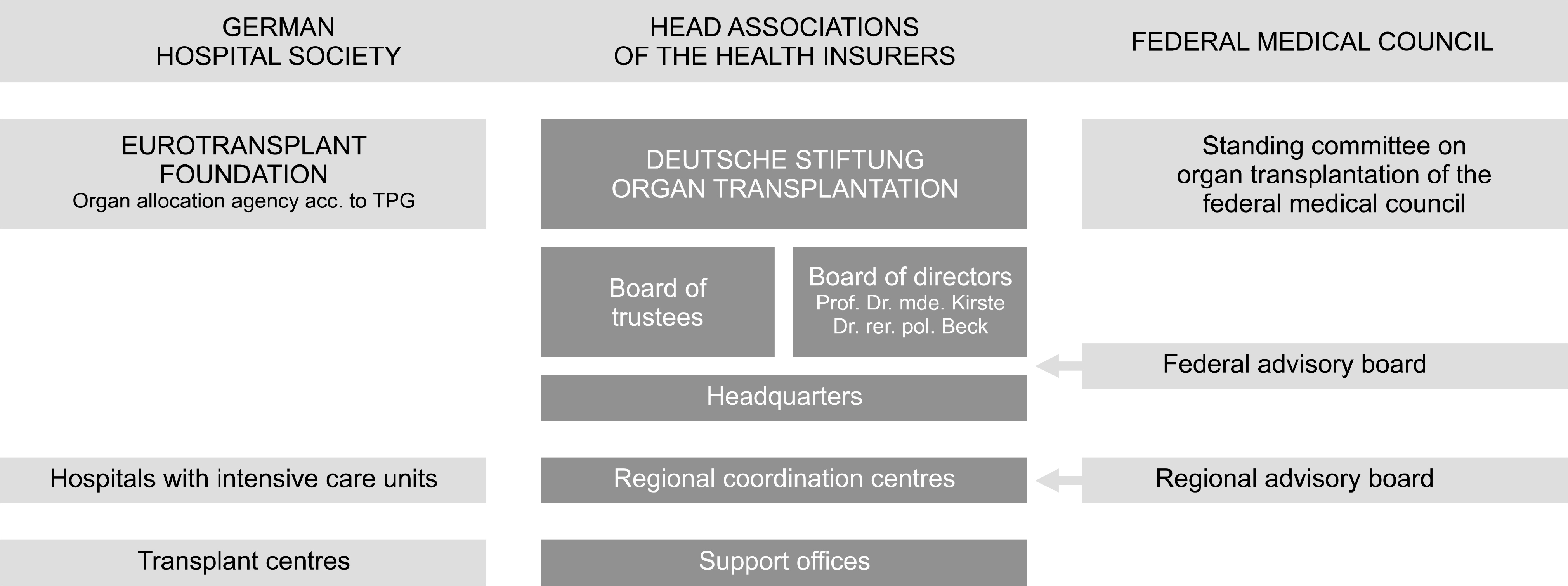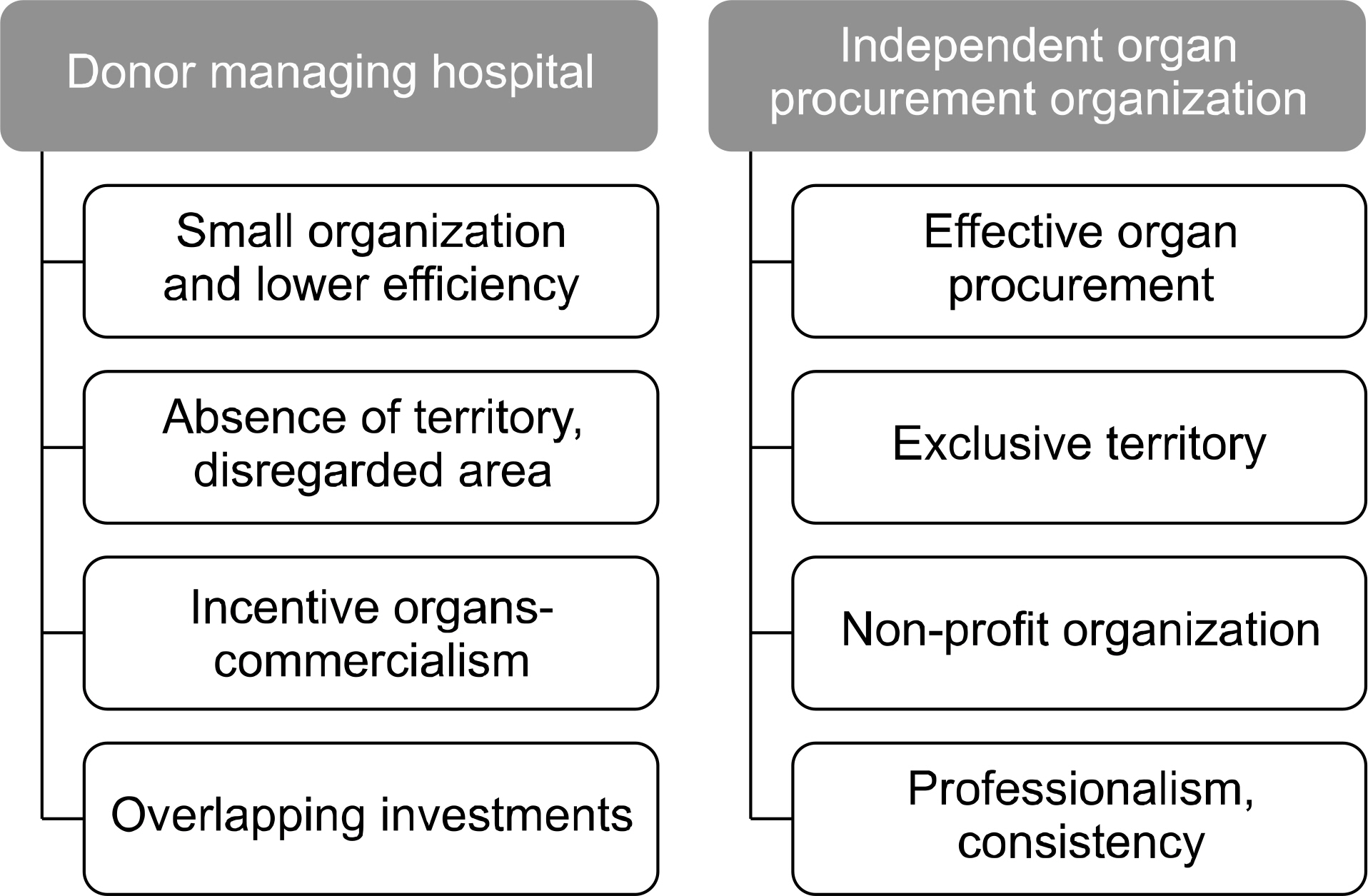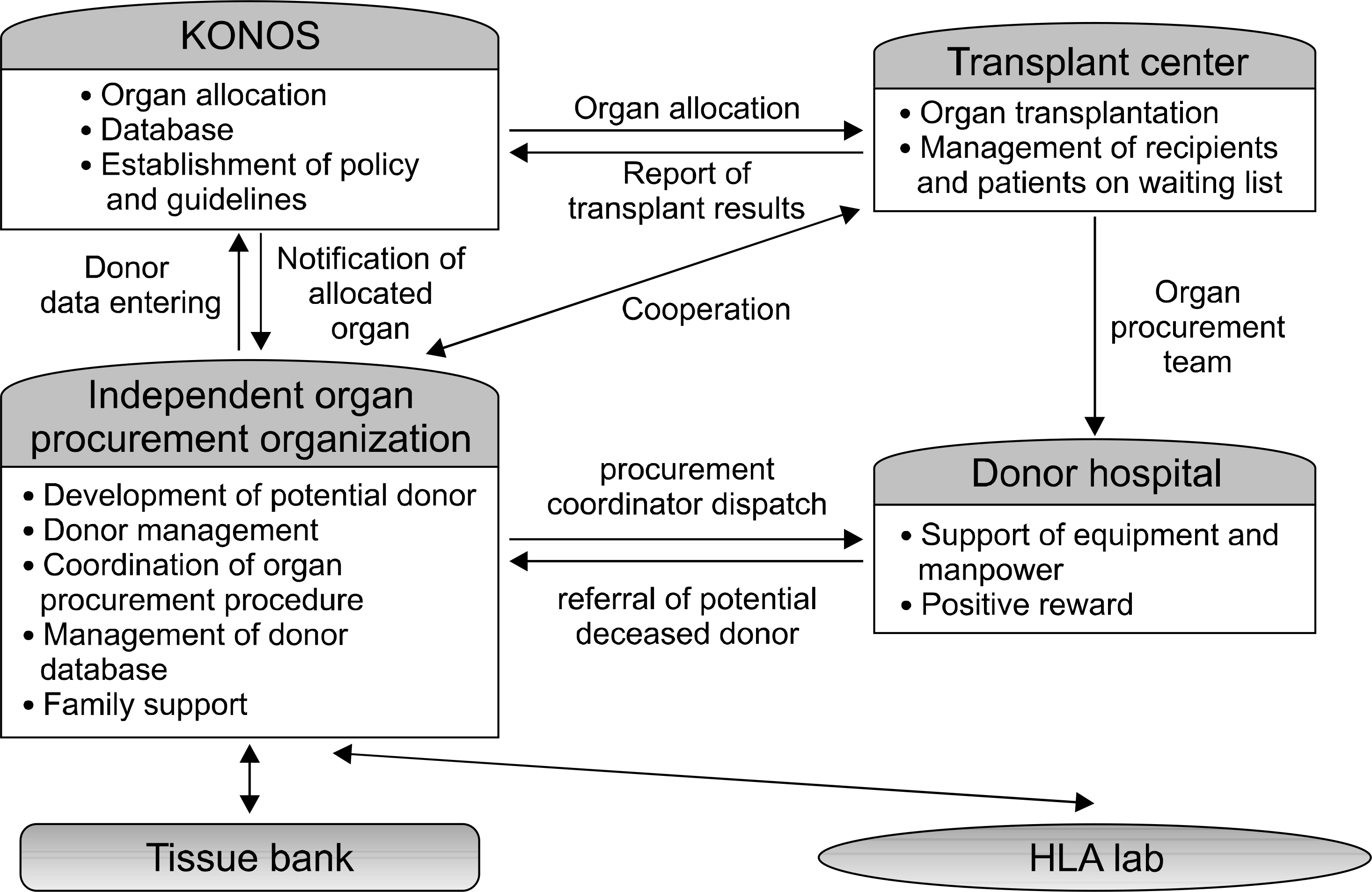J Korean Soc Transplant.
2011 Mar;25(1):1-7. 10.4285/jkstn.2011.25.1.1.
Optimal System for Deceased Organ Donation and Procurement in Korea
- Affiliations
-
- 1Department of Surgery, Seoul National University College of Medicine, Seoul, Korea. jwhamd@snu.ac.kr
- 2Department of Surgery, Keimyung University School of Medicine, Daegu, Korea.
- 3Department of Internal Medicine, Seoul National University College of Medicine, Seoul, Korea.
- 4Transplant Research Institute, Seoul National University Medical Research Center, Seoul, Korea.
- 5Department of Surgery, Yonsei University College of Medicine, Seoul, Korea.
- KMID: 2202342
- DOI: http://doi.org/10.4285/jkstn.2011.25.1.1
Abstract
- Since the first deceased donor kidney transplantation in 1979, continuous efforts have been made to increase deceased organ donation in Korea. However, a critical shortage of human organs for transplant is still a serious problem and is partly caused by the absence of a system to actively identify and properly manage deceased donors in Korea. Considering this, Korea needs to create a new national system for deceased donor identification, management, and organ procurement. There are three kinds of organ procurement systems in the world: The "Spanish model", the "United States model", and the "other European model". We reviewed each system and suggested the optimal organ procurement system for Korea. We also proposed requirements for operating an organ procurement organization and increasing deceased organ donation. Further improvements in the organ procurement system will contribute to improve the current organ shortage.
MeSH Terms
Figure
Cited by 2 articles
-
Waiting Time for Deceased Donor Kidney Allocation in Korea: A Single Center Experience
Su Hyung Lee, Kyu Ha Huh, Hyung Soon Lee, Hyun Jung Kim, Myoung Soo Kim, Dong Jin Joo, Soon Il Kim, Yu Seun Kim
J Korean Soc Transplant. 2012;26(1):32-37. doi: 10.4285/jkstn.2012.26.1.32.Current System for Allocation of Deceased Donor Kidney Transplantation
Mina Kim, Seirhan Kim, Su Hyung Lee, Chang-Kwon Oh, Jun Bae Bang
J Korean Soc Transplant. 2017;31(3):143-149. doi: 10.4285/jkstn.2017.31.3.143.
Reference
-
References
1). Korean Network for Organ Sharing (KONOS). 2008 Annual data report [Internet]. Seoul: KONOS;2009. Available from:. http://www.konos.go.kr.2). Korean Network for Organ Sharing (KONOS) [Internet]. Seoul: KONOS;2010. [cited 2010 Nov 25]. Available from:. http://www.konos.go.kr.3). Steering Committee of the Istanbul Summit. Organ trafficking and transplant tourism and commercialism: the Declaration of Istanbul. Lancet. 2008; 372:5–6.4). World Health Organization (WHO). Human organ and tissue transplantation [Internet]. Geneva: WHO;2010. [cited 2010 Nov 25]. Available from:. http://www.who.int/ethics/topics/human_transplant/en.5). Noël L, Martin D. Progress towards national self-suffi-ciency in organ transplants. Bull World Health Organ. 2009; 87:647.
Article6). Min SI, Kim SY, Park YJ, Min SK, Kim YS, Ahn C, et al. Trends in deceased organ donation and utilization in Korea: 2000–2009. J Korean Med Sci. 2010; 25:1122–7.
Article7). Kwak JY, Park CD, Lee KS, Won CK, Kang CM, Park HC, et al. An analysis of 15 cases of cadaveric kidney transplantation. J Korean Surg Soc. 1993; 44:128–36. (곽진영, 박찬대, 이광수, 원치규, 강종명, 박한철, 등. 사체신이식 15예의 결과 분석. 대한외과학회지 1993;44: 128–36.).8). Kim ST, Park YH, Lee KU, Yoon YK, Kim SW, Yang HK, et al. An experience of liver transplantation in Korea. J Korean Soc Transplant. 1988; 2:27–36. (김수태, 박용현, 이건욱, 김상준, 윤여규, 김선회, 양한광, 등. 한국 최초 간이식예 보고. 대한이식학회지 1988;2: 27–36.).9). Kim MS, Kim SI, Kim YS. Current status of deceased donor organ recovery and sharing in Korea. J Korean Med Assoc. 2008; 51:685–91. (김명수, 김순일, 김유선. 뇌사자 발생과 뇌사자 장기분배의 국내현황. 대한의사협회지 2008;51: 685–91.).
Article10). Han YJ, Lee YH, et al. A proposal of brain death donors management. Seoul: the Korea Institute for Health and Social Affairs; 2003. (한영자, 이연희, 등. 뇌사자관리 활성화 방안. 서울: 한국보건사회연구원: 한국보건사회연구원;2003. .).11). Ministry of Health and Welfare. Measures to improve organ donation. Seoul: Ministry of Health and Welfare;2005.12). Cho WH, Kim HT, Lee HJ, Seo YM, Lee SD, Son EI, et al. Development of Korean model for independent organ procurement organization. J Korean Soc Transplant. 2008; 22:109–19. (조원현, 김형태, 이현진, 서영민, 이상도, 손은익, 등. 지역 장기구득기관의 한국형 모델 개발. 대한이식학회지 2008;22: 109–19.).13). Park YJ, Kang H, Kim EM, Shin WY, Yi NJ, Suh KS, et al. Establishment of active iIdentification and management system for potential brain dead donors in life-link center. J Korean Soc Transplant. 2009; 23:43–51. (박양진, 강현진, 김은만, 신우영, 이남준, 서경석, 등. 생명 연결본부: 능동적인 잠재뇌사자 발굴신고 및 뇌사장기기증자 관리체계 구축. 대한이식학회지 2009;23: 43–51.).14). Organización Nacional de Trasplantes (ONT) [Internet]. Madrid, Spain: ONT;2010. [cited 2010 Nov 25]. Available from:. http://www.ont.es/Home/Paginas/default.aspx.15). Cuende N, Cañon JF, Miranda B, Alonso M. The organ donor process: a programme for its evaluation and improvement. Organs Tissues. 2002; 2:109–18.16). Miranda B, Vilardell J, Grinyó JM. Optimizing cadaveric organ procurement: the catalan and Spanish experience. Am J Transplant. 2003; 3:1189–96.
Article17). Herbertt K, Dahlenburg G. Organ donation in South Australia: experience with a modified Spanish model. Transplant Rev. 2001; 15:46–9.
Article18). Simini B. Tuscany doubles organ-donation rates by following Spanish example. Lancet. 2000; 355:476.
Article19). Matesanz R. Factors influencing the adaptation of the Spanish Model of organ donation. Transpl Int. 2003; 16:736–41.
Article20). Chang GJ, Mahanty HD, Ascher NL, Roberts JP. Expanding the donor pool: can the Spanish model work in the United States? Am J Transplant. 2003; 3:1259–63.
Article21). Kirkman RL, Milford EL, Luskin RS. The New England Organ Bank–lessons from running a regional organ bank. Clin Transpl. 1993; 317–24.22). Prottas JM. The organization of organ procurement. J Health Polit Policy Law. 1989; 14:41–55.
Article23). The Organ Procurement and Transplantation Network (OPTN) [Internet]. Richmomd, VA: OPTN;2010. [cited 2010 Nov 26]. Available from:. http://optn.transplant.hrsa.gov.24). United Network for Organ Sharing (UNOS) [Internet]. Richmond, VA: UNOS;2010. [cited 2010 Nov 26]. Available from:. http://www.unos.org.25). Marks WH, Wagner D, Pearson TC, Orlowski JP, Nelson PW, McGowan JJ, et al. Organ donation and utilization, 1995–2004: entering the collaborative era. Am J Transplant. 2006; 6:1101–10.
Article26). Wesslau C, Grosse K, Krüger R, Kücük O, Mauer D, Nitschke FP, et al. How large is the organ donor potential in Germany? Results of an analysis of data collected on deceased with primary and secondary brain damage in intensive care unit from 2002 to 2005. Transpl Int. 2007; 20:147–55.
Article27). Gubernatis G. Organization of organ donation–concepts and experiences in Niedersachsen/Ostwestfalen. Nephrol Dial Transplant. 1999; 14:2309–14.
Article28). Deutsche Stiftung Organtransplantation (DSO) [Internet]. Frankfurt: DSO;2010. [cited 2010 Nov 26]. Available from:. http://www.dso.de.29). Han YJ, Hwang YS, Lee SK, Goh EN, Lee NH. A report on the establishment and management of organ procurement organization. Seoul: the Korea Institute for Health and Social Affairs; 2006. (한영자, 황유성, 이선규, 고은나, 이난희. 장기구득기관 설립 및 운영방안 연구. 서울: 한국보건사회연구원: 한국보건사회연구원;2006. .).30). Siminoff LA, Gordon N, Hewlett J, Arnold RM. Factors influencing families' consent for donation of solid organs for transplantation. JAMA. 2001; 286:71–7.
Article31). Mone TD. The business of organ procurement. Curr Opin Organ Transplant. 2002; 7:60–4.
Article32). Transplant Procurement Management (TPM) [Internet]. Barcelona: TPM;2010. [cited 2010 Nov 28]. Available from:. http://tpm.org.33). Industry-academic Cooperation Foundation, Keimyung University. Investigation of Deceased Organ Donation System in Foreign Country. Seoul: National Medical Center; 2009. (계명대학교 산학협력단. 외국의 뇌사장기기증체계 조사연구 – 실제적인 발굴 관리 중심으로. 서울: 국립의료원: 국립의료원;2009. .).
- Full Text Links
- Actions
-
Cited
- CITED
-
- Close
- Share
- Similar articles
-
- National Organ Transplantation Policy
- Status of Organ Donation and Solution of Organ Shortage in Korea
- Management of brain-dead donors in Korea
- Organ donation in Korea in 2018 and an introduction of the Korea national organ donation system
- Trends in Deceased Organ Donation and Utilization in Korea: 2000-2009




